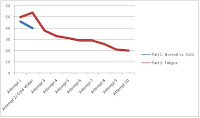The purpose of this lab is to observe the characteristics of muscle contraction and then investigate the effects of two factors - temperature and fatigue - on the action of your muscles.
First, I tested the effects of cold on the muscles. I recorded how many times I could make a fist in 20 seconds. Then, I submerged my forearm in ice cold water and repeated the first step.
# of fists in 20 seconds- 46
# of fists in 20 seconds after cold water- 40
# of fists in 20 seconds after cold water- 40
Then, for the second part of the lab, I tested the effects of fatigue. The lab said to use a rubber ball or a clothespin, but I don’t own either, so I used one of my son’s bath toys, a little soft rubber octopus. I squeezed the octopus for 20 seconds and repeated it 9 more times, for a total of ten trials, without taking a break in between.
What are the three changes you observed in a muscle while it is working (contracted)?
I noticed that it grew larger in size, tension increased with repetitions, after the seventh trial, my muscles started to burn and ache.
What effect did the cold temperature have on the action of your hand muscles? Explain.
The cold water caused my muscles to constrict, making it harder to open and close my hand. When the muscles get cold, they constrict to produce heat in attempts to raise the body temperature and maintain homeostasis.
What effect did the fatigue have on the action of your hand muscles? Explain.
Fatiguing my muscles also caused them to constrict. Arm muscles contain Fast- Twitch muscle fibers. They rely on an anaerobic means of acquiring ATP, provide explosions of energy, and can develop maximum tension more rapidly than slow- twitch muscle fibers. However, because they use an anaerobic means of acquiring ATP, it leaves them vulnerable to an accumulation of Lactate, causing them to fatigue quickly.
I noticed that it grew larger in size, tension increased with repetitions, after the seventh trial, my muscles started to burn and ache.
What effect did the cold temperature have on the action of your hand muscles? Explain.
The cold water caused my muscles to constrict, making it harder to open and close my hand. When the muscles get cold, they constrict to produce heat in attempts to raise the body temperature and maintain homeostasis.
What effect did the fatigue have on the action of your hand muscles? Explain.
Fatiguing my muscles also caused them to constrict. Arm muscles contain Fast- Twitch muscle fibers. They rely on an anaerobic means of acquiring ATP, provide explosions of energy, and can develop maximum tension more rapidly than slow- twitch muscle fibers. However, because they use an anaerobic means of acquiring ATP, it leaves them vulnerable to an accumulation of Lactate, causing them to fatigue quickly.




No comments:
Post a Comment